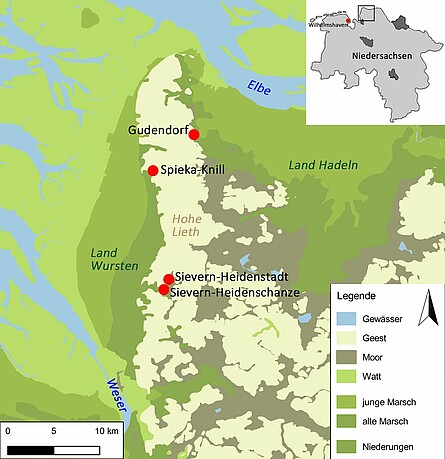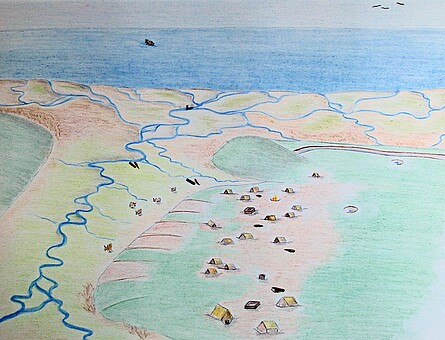Fortifications in the Coastal Zone of the Western Elbe-Weser Triangle as a Structural Basis of Communication- and Trade Routes of the Roman Iron Age and Migration Period
Closely linked to research into the reconstruction of the occupation- and landscape history of the Sievern Area are current investigations in the micro regions of Cuxhaven-Gudendorf and Spieka-Knill, both situated in the northern extent of the “Hohe Lieth” moraine ridge and both displaying structural parallels with the aforementioned region.
Vestiges and remains of a Roman Iron Age settlement fortified with ditch and rampart were the starting point for the investigations in the Gudendorf region, which had been funded by the Lower Saxony Ministry for Science and Culture within the scope of the Pro*Niedersachsen Programme between 2013 and 2015. The study was undertaken by Iris Aufderhaar M.A., with temporary support on aspects of landscape history from Imke Brandt M.A. und Dr. Annette Siegmüller.
The significant position of the region around Gudendorf is reflected – as is the case in the Sievern region – in a marked concentration of finds coming from the Roman Empire and reaching the northern tip of the Elbe-Weser Triangle where they are found both in cemeteries as well as in settlements along the Elbe estuary. The 2014 evaluations and sondages at Cuxhaven-Gudendorf uncovered evidence for a fortification comprising a rampart and several ditches which enclosed a settlement area with a dense cover of houses and Grubenhäuser. This confirmed the existence at this site of a fortified settlement during the Roman Iron Age and early Migration Period. Likewise, the historic discovery of a gold bracteate in the Spieka region suggests that this region was part of a transregional communication network during the Migration Period. Sondages carried out in the immediate vicinity of the bracteate’s findspot in 2015 resulted in the partial uncovering of an extensive settlement of the Roman Iron Age and Migration Period. Again, the buildings included both longhouses as well as Grubenhäuser. The finds assemblage provides evidence not only for local craft activities, but fragments of samian ware are again indicative of the settlement’s integration into the interregional communication network. Further information is available here.
Bibliography
Aufderhaar, I. u. Siegmüller, A., 2015: Befestigungen und Siedlungen im nordwestlichen Elbe-Weser-Dreieck – Erste Ergebnisse der Untersuchungen in Gudendorf und Spieka-Knill. Siedlungs- und Küstenforschung im südlichen Nordseegebiet 38, 145-171.


